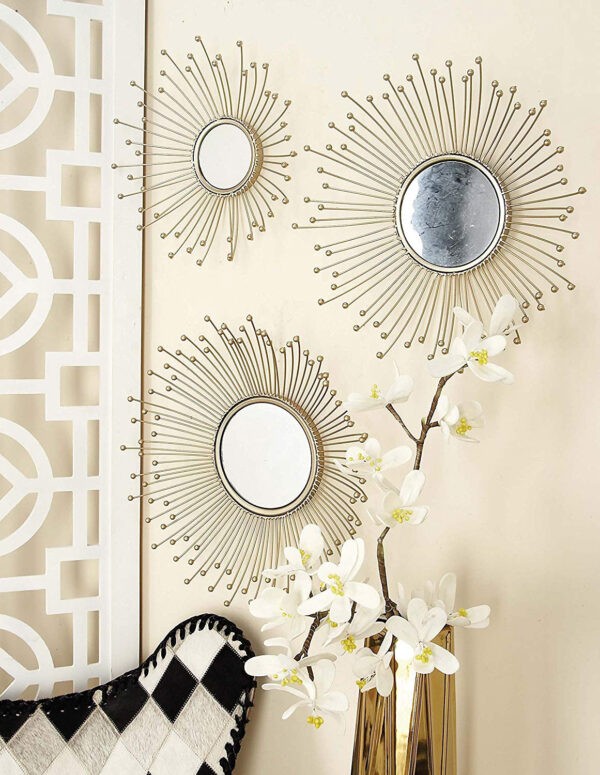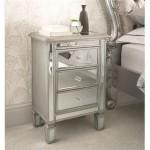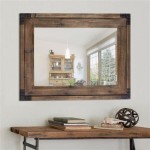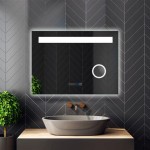Decorative Mirror Designs: Enhancing Spaces with Reflection and Style
Mirrors, beyond their utilitarian function of reflecting images, have evolved into significant decorative elements in interior design. They possess the unique ability to enhance a space's aesthetic appeal, create illusions of greater size, and amplify natural light. Decorative mirrors are available in a wide array of designs, styles, and materials, catering to diverse preferences and interior design schemes. This article explores the various aspects of decorative mirror designs, offering insights into their types, applications, and considerations for selection.
Types of Decorative Mirror Designs
The classification of decorative mirrors can be attributed to various factors, including their shape, frame material, style, and intended application. Understanding these distinctions is crucial for selecting the most appropriate mirror for a specific space and design goal.
Shape and Size: Mirrors come in a multitude of shapes, ranging from classic geometric forms like rectangles, squares, and circles to more organic and abstract designs. Rectangular mirrors are often used in bathrooms and hallways, providing a full-length reflection. Square mirrors can be incorporated into gallery walls or used as accent pieces. Circular mirrors offer a softer, more contemporary aesthetic, particularly when used above console tables or in living rooms. The size of the mirror is equally important, as larger mirrors are ideal for creating a sense of spaciousness, while smaller mirrors may serve as subtle decorative accents.
Frame Materials: The frame material significantly impacts the overall style and aesthetic of the mirror. Common frame materials include wood, metal, glass, and resin. Wooden frames offer a traditional and rustic appeal, often featuring intricate carvings or distressed finishes. Metal frames, such as those made from wrought iron, brass, or stainless steel, provide a modern and industrial touch. Glass frames, whether clear or colored, can add a sleek and elegant element to a space. Resin frames are versatile and can be molded into various shapes and designs, making them suitable for contemporary and eclectic interiors.
Style and Design: Decorative mirrors are available in a wide range of styles, including traditional, modern, contemporary, rustic, vintage, and eclectic. Traditional mirrors often feature ornate frames with intricate details, such as scrolls, floral motifs, and gilded finishes. Modern mirrors are characterized by clean lines, minimalist designs, and streamlined shapes. Contemporary mirrors encompass a broader range of styles, often incorporating asymmetrical shapes, bold colors, and unique textures. Rustic mirrors typically feature raw materials, such as reclaimed wood or distressed metal, evoking a sense of natural charm. Vintage mirrors may showcase antique frames with weathered finishes, lending a touch of history and character to a space. Eclectic mirrors combine elements from different styles, creating a unique and personalized look.
Specific Applications: Mirrors can be designed for specific areas within a home or commercial space. Bathroom mirrors are often illuminated and feature anti-fog coatings. Vanity mirrors are designed to provide optimal lighting for grooming and makeup application. Full-length mirrors are ideal for bedrooms and dressing rooms, allowing for a complete view of one's attire. Wall mirrors can be used in any room to enhance the sense of space and light. Console mirrors are typically placed above console tables in entryways or living rooms, creating a focal point. Leaning mirrors are large mirrors that rest against a wall, adding a casual and stylish touch to a space. Overmantel mirrors are designed to be placed above fireplaces, enhancing the fireplace's presence and reflecting light throughout the room.
Applications of Decorative Mirrors in Interior Design
Decorative mirrors are versatile elements that can be strategically incorporated into various spaces to achieve specific design goals. Their ability to manipulate light, create visual illusions, and enhance aesthetics makes them invaluable tools for interior designers and homeowners.
Enhancing Natural Light: Mirrors are highly effective at reflecting and amplifying natural light within a space. Positioning a mirror opposite a window can significantly increase the amount of light that permeates the room, making it feel brighter and more inviting. This is particularly beneficial in rooms with limited natural light or in spaces with dark color schemes.
Creating the Illusion of Space: Mirrors can create the illusion of a larger space, making them ideal for small apartments, narrow hallways, and compact bathrooms. A large mirror placed on a prominent wall can visually double the size of the room. Strategically positioned mirrors can also create the illusion of depth, making a space feel more open and airy.
Adding Visual Interest: Decorative mirrors can serve as focal points, adding visual interest and personality to a space. A unique mirror with an eye-catching frame or an unconventional shape can draw attention and become a conversation starter. Mirrors can also be used to create gallery walls, combining various shapes, sizes, and styles to create a dynamic and personalized display.
Defining Focal Points: Mirrors can be used to accentuate and define focal points within a room. Placing a mirror above a fireplace, console table, or headboard can draw attention to these features and enhance their visual impact. Mirrors can also be used to reflect artwork or other decorative objects, creating a layered and visually rich composition.
Adding Texture and Depth: Mirrors with textured frames or beveled edges can add depth and dimension to a space. Frames made from natural materials, such as wood or stone, can introduce textural elements that complement the overall design scheme. Beveled edges create subtle shadows and highlights, adding visual interest to the mirror's surface.
Complementing Color Schemes: The frame of a decorative mirror can be chosen to complement the existing color scheme of a room. A mirror with a metallic frame can add a touch of glamour to a space with neutral colors. A mirror with a brightly colored frame can serve as a pop of color in a room with a more muted palette. The reflected image in the mirror can also contribute to the overall color balance of the space.
Considerations for Selecting Decorative Mirrors
Selecting the right decorative mirror requires careful consideration of various factors, including the size and style of the room, the existing decor, and the desired aesthetic. A well-chosen mirror can elevate the overall design of a space, while a poorly chosen mirror can detract from its visual appeal.
Scale and Proportion: The size of the mirror should be proportionate to the size of the wall and the furniture around it. A large mirror can overwhelm a small space, while a small mirror can get lost on a large wall. Consider the dimensions of the wall and the surrounding furniture when selecting a mirror to ensure a balanced and harmonious composition.
Style Compatibility: The style of the mirror should complement the overall style of the room. A traditional mirror may look out of place in a modern, minimalist space, while a contemporary mirror may clash with a rustic, farmhouse-style interior. Choose a mirror that aligns with the existing design scheme to create a cohesive and visually pleasing result.
Placement and Function: Consider the intended placement of the mirror and its primary function. A mirror placed in a hallway should be large enough to provide a full-length reflection, while a mirror placed above a console table should be appropriately sized to complement the table's dimensions. Also, consider the light sources in the room and position the mirror to maximize the reflection of natural or artificial light.
Frame Material and Finish: The frame material and finish should be chosen to complement the existing hardware and finishes in the room. A mirror with a metal frame can coordinate with metal light fixtures or door hardware. A mirror with a wooden frame can complement wooden furniture or flooring. Consider the overall color palette and choose a frame color that complements the existing colors in the space.
Mirror Quality and Durability: Opt for a mirror made from high-quality glass with a durable frame. A high-quality mirror will provide a clear and accurate reflection, while a durable frame will ensure that the mirror lasts for years to come. Check for any imperfections in the glass, such as scratches or bubbles, and ensure that the frame is securely assembled.
Budget: Decorative mirrors are available at a wide range of price points. Set a realistic budget before beginning the selection process to avoid overspending. Consider the long-term value of the mirror and choose a high-quality option that will withstand the test of time.
By carefully considering these factors, individuals can select decorative mirrors that enhance the beauty, functionality, and overall ambiance of their living spaces.

Decorative Wall Mirrors 40 Design Catalogue For Living Room Hallway Bathroom

Image Gallery Page 426153183488350696 Artofit Interior Wall Design Hall Decor Entryway

Wall Mirror Designs Elevate Your Home Decor

7 Best Ways To Enhance Your Wall Mirrors In 2024

51 Decorative Wall Mirrors To Fill That Empty Space In Your

Mirror Decoration For Home 15 Ideas To Decorate With Mirrors

Wall Mirror Designs Elevate Your Home Decor

How To Choose The Ideal Wall Mirror For Your Room Majestic Glass

9 Decorative Wall Mirror Designs To Transform Your Space

Mirror Decoration For Home 15 Ideas To Decorate With Mirrors








